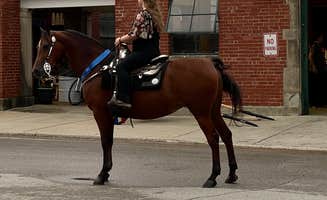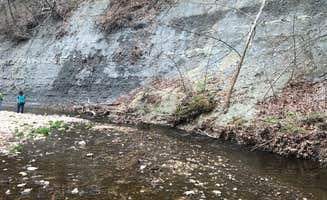Jim Edgar Panther Creek State Fish and Wildlife Area encompasses over 16,000 acres of diverse terrain in central Illinois, located approximately 25 miles northwest of Jacksonville. The area features rolling hills and wooded valleys with elevation changes of up to 100 feet in some sections. Summer temperatures typically range from 70-90°F with moderate humidity, while spring brings occasional heavy rainfall that can affect trail conditions.
What to do
Fishing at Prairie Lake: Electric-only motors allowed on the 149-acre fishing lake at Jim Edgar Panther Creek - Family Campground. "Lots of hunting and fishing opportunities but grounds are years always from being fully grown. Always super windy too!" notes Lucas T.
Hiking through diverse terrain: Multiple trail systems offer varied difficulty levels from easy lakeside walks to more challenging woodland routes. At Siloam Springs State Park Campground, "They have great hikes throughout the area. You can rent kayaks, canoes, and boats and fish in many locations," shares Hannah S. "The trails are pretty well marked and are best in mid/late fall or early spring."
Wildlife observation: Early morning or evening hours provide the best opportunities for spotting white-tailed deer, wild turkeys, and various bird species. A visitor at McCully Heritage Project mentions, "Very well maintained. Neat look out points" for wildlife viewing across the valleys.
What campers like
Quiet atmosphere: Many equestrian camping areas near Jacksonville maintain a more relaxed environment compared to busier state parks. At Primitive Campground — Jim Edgar Panther Creek State Fish and Wildlife Area, campers appreciate that "It is shaded, private, has a shelter, picnic table, and fire pit that you can cook on," according to Chelle L.
Affordability: Camping fees remain reasonable throughout the region. "Just $6 a night" for primitive sites, notes Amanda C. "Very friendly and helpful campground host drove over from the RV campground to register us and even offered to take our stuff to our site."
Spacious sites: Deer Run Campground — Sangchris Lake State Park receives praise for its layout. "The sites were large and the primitive sites at the back were incredibly beautiful! The prices were very low," reports Colin H.
What you should know
Weather considerations: The region experiences significant seasonal variations. Summer can be hot and humid with temperatures regularly above 85°F. "It would be hot as blazes in mid summer" without adequate shade, warns Sheryl K. Spring brings frequent rainfall that can affect trail conditions.
Reservation requirements: Most equestrian campsites require advance booking, especially during peak season (April-October). At Sangchris Lake State Park Campground, "If you want a lake spot, make a reservation way in advance," advises Rhonda W.
Limited cell service: Coverage varies significantly throughout the area. While some campgrounds offer decent connectivity, remote sections have minimal signal. "I was able to get internet with Verizon" reports Susan L., though reception quality fluctuates throughout the park.
Tips for camping with families
Playground access: Several campgrounds feature dedicated play areas for children. At Deer Run Campground, "Playground was great for kiddos" notes J N., providing a convenient activity option close to campsites.
Educational opportunities: McCully Heritage Project offers nature programs during summer months. "Super inexpensive for the space that you get. Free firewood," shares Eric. "We have only stayed at the largest site as it has good fishing and a place for us to launch our paddleboards and kayaks."
Safety precautions: Watch for poison ivy along trails and near primitive camping areas. "Watch out for the poison ivy and get a map from an employee to hike the trails. They can be hard to find but camping is fantastic!" advises Chelle L.
Tips from RVers
Power limitations: During peak usage periods, electrical systems at some campgrounds may become strained. "I stayed here right after the fourth of July and because of the heat over this holiday weekend and a completely full campground, the electricity couldn't meet the demand and a transformer blew," reports Susan L.
Water access planning: Water spigots are centrally located rather than at individual sites in many campgrounds. "Site has electricity with water centrally located in the center of the loop. We needed a 100 ft fresh water hose to fill up," notes Jennifer K.
Wind protection: Consider wind direction when setting up at exposed campsites. "This campground seemed well laid out and was affordable," says Brandy C., though others mention that certain areas "can be pretty windy" especially in open sections.



